Impact of Training & Development on Organizational Performance
VerifiedAdded on 2023/04/23
|12
|3240
|167
Report
AI Summary
This report delves into the critical role of training and development within organizations, exploring its multifaceted impact on employee performance, corporate success, and organizational culture. The introduction establishes the significance of continuous learning and development in fostering employee growth and achieving business objectives. The discussion section defines training and development, outlining various approaches and techniques such as mentoring and on-the-job training. It then examines the strategic importance of training and development planning and implementation in achieving corporate success, highlighting how it equips employees with the necessary skills and knowledge. The report further analyzes the impact of relevant training and development techniques on company performance, emphasizing their role in improving productivity, minimizing errors, and enhancing teamwork. Furthermore, it explores the intricate relationship between training and development and organizational culture, demonstrating how well-designed programs can foster a positive work environment and increase employee satisfaction. The report also shares experiences of training influencing organizational culture. The conclusion summarizes the key findings and reinforces the importance of strategic training and development initiatives for sustainable organizational growth and success.
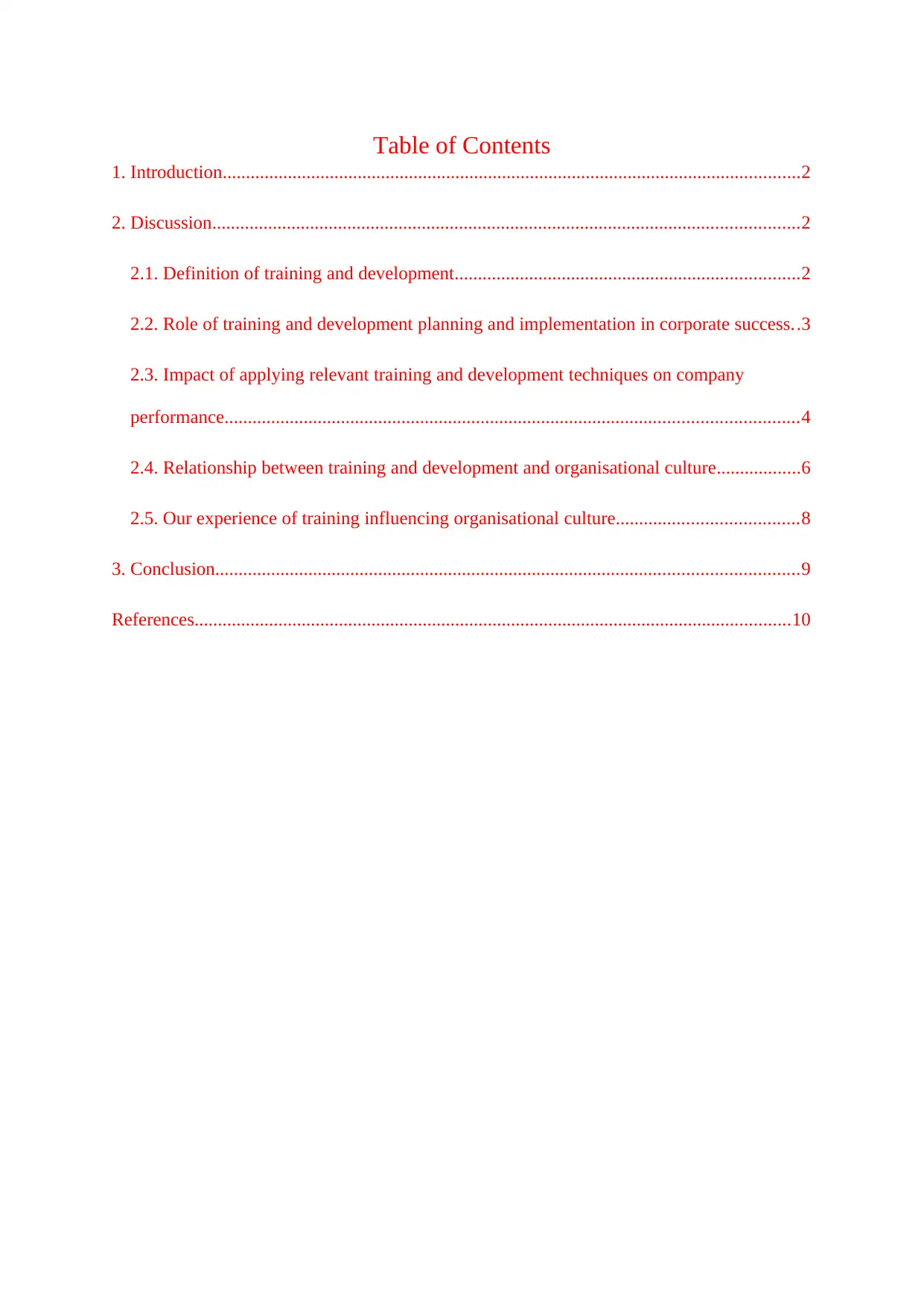
Table of Contents
1. Introduction............................................................................................................................2
2. Discussion..............................................................................................................................2
2.1. Definition of training and development..........................................................................2
2.2. Role of training and development planning and implementation in corporate success..3
2.3. Impact of applying relevant training and development techniques on company
performance...........................................................................................................................4
2.4. Relationship between training and development and organisational culture..................6
2.5. Our experience of training influencing organisational culture.......................................8
3. Conclusion.............................................................................................................................9
References................................................................................................................................10
1. Introduction............................................................................................................................2
2. Discussion..............................................................................................................................2
2.1. Definition of training and development..........................................................................2
2.2. Role of training and development planning and implementation in corporate success..3
2.3. Impact of applying relevant training and development techniques on company
performance...........................................................................................................................4
2.4. Relationship between training and development and organisational culture..................6
2.5. Our experience of training influencing organisational culture.......................................8
3. Conclusion.............................................................................................................................9
References................................................................................................................................10
Paraphrase This Document
Need a fresh take? Get an instant paraphrase of this document with our AI Paraphraser
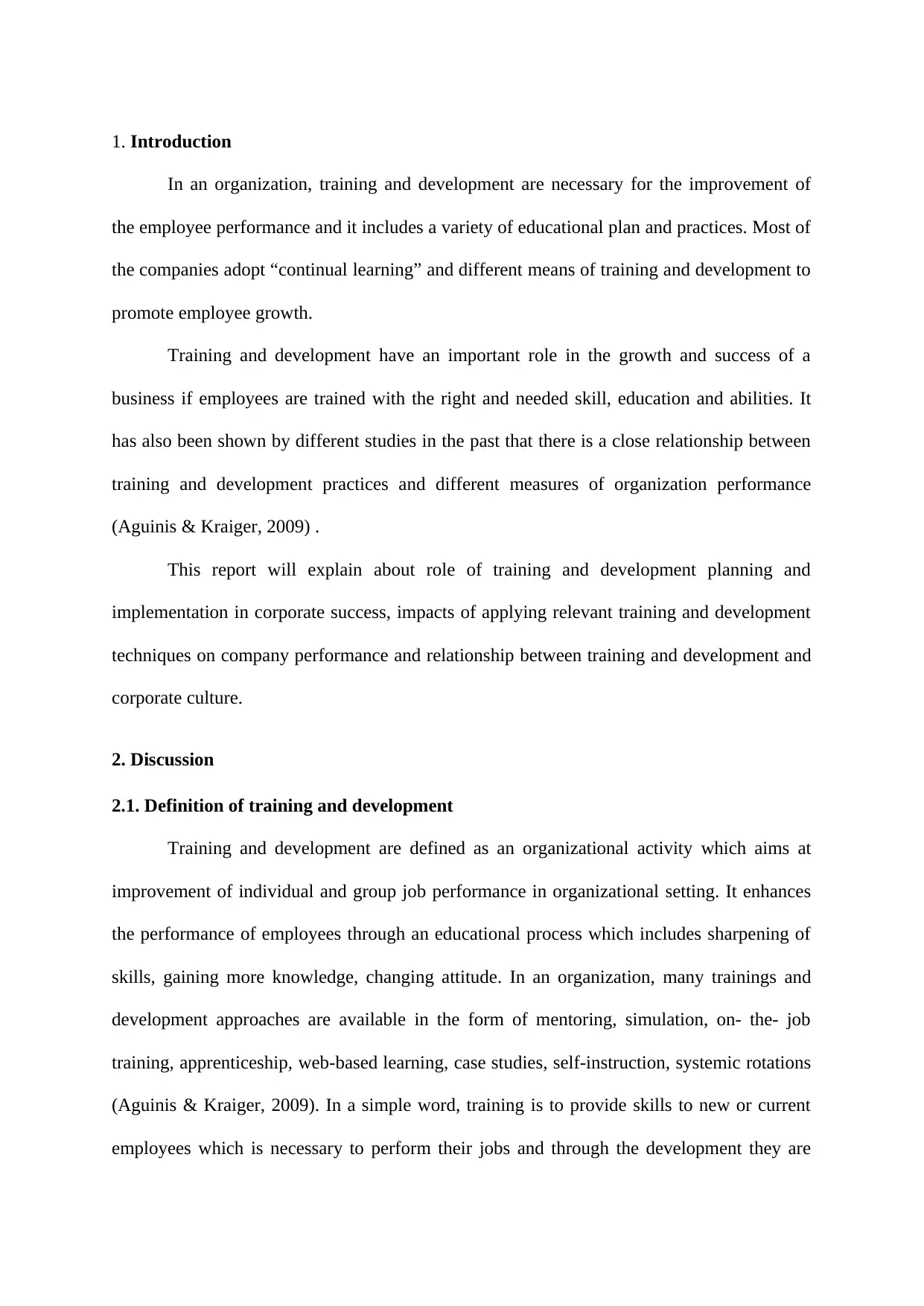
1. Introduction
In an organization, training and development are necessary for the improvement of
the employee performance and it includes a variety of educational plan and practices. Most of
the companies adopt “continual learning” and different means of training and development to
promote employee growth.
Training and development have an important role in the growth and success of a
business if employees are trained with the right and needed skill, education and abilities. It
has also been shown by different studies in the past that there is a close relationship between
training and development practices and different measures of organization performance
(Aguinis & Kraiger, 2009) .
This report will explain about role of training and development planning and
implementation in corporate success, impacts of applying relevant training and development
techniques on company performance and relationship between training and development and
corporate culture.
2. Discussion
2.1. Definition of training and development
Training and development are defined as an organizational activity which aims at
improvement of individual and group job performance in organizational setting. It enhances
the performance of employees through an educational process which includes sharpening of
skills, gaining more knowledge, changing attitude. In an organization, many trainings and
development approaches are available in the form of mentoring, simulation, on- the- job
training, apprenticeship, web-based learning, case studies, self-instruction, systemic rotations
(Aguinis & Kraiger, 2009). In a simple word, training is to provide skills to new or current
employees which is necessary to perform their jobs and through the development they are
In an organization, training and development are necessary for the improvement of
the employee performance and it includes a variety of educational plan and practices. Most of
the companies adopt “continual learning” and different means of training and development to
promote employee growth.
Training and development have an important role in the growth and success of a
business if employees are trained with the right and needed skill, education and abilities. It
has also been shown by different studies in the past that there is a close relationship between
training and development practices and different measures of organization performance
(Aguinis & Kraiger, 2009) .
This report will explain about role of training and development planning and
implementation in corporate success, impacts of applying relevant training and development
techniques on company performance and relationship between training and development and
corporate culture.
2. Discussion
2.1. Definition of training and development
Training and development are defined as an organizational activity which aims at
improvement of individual and group job performance in organizational setting. It enhances
the performance of employees through an educational process which includes sharpening of
skills, gaining more knowledge, changing attitude. In an organization, many trainings and
development approaches are available in the form of mentoring, simulation, on- the- job
training, apprenticeship, web-based learning, case studies, self-instruction, systemic rotations
(Aguinis & Kraiger, 2009). In a simple word, training is to provide skills to new or current
employees which is necessary to perform their jobs and through the development they are
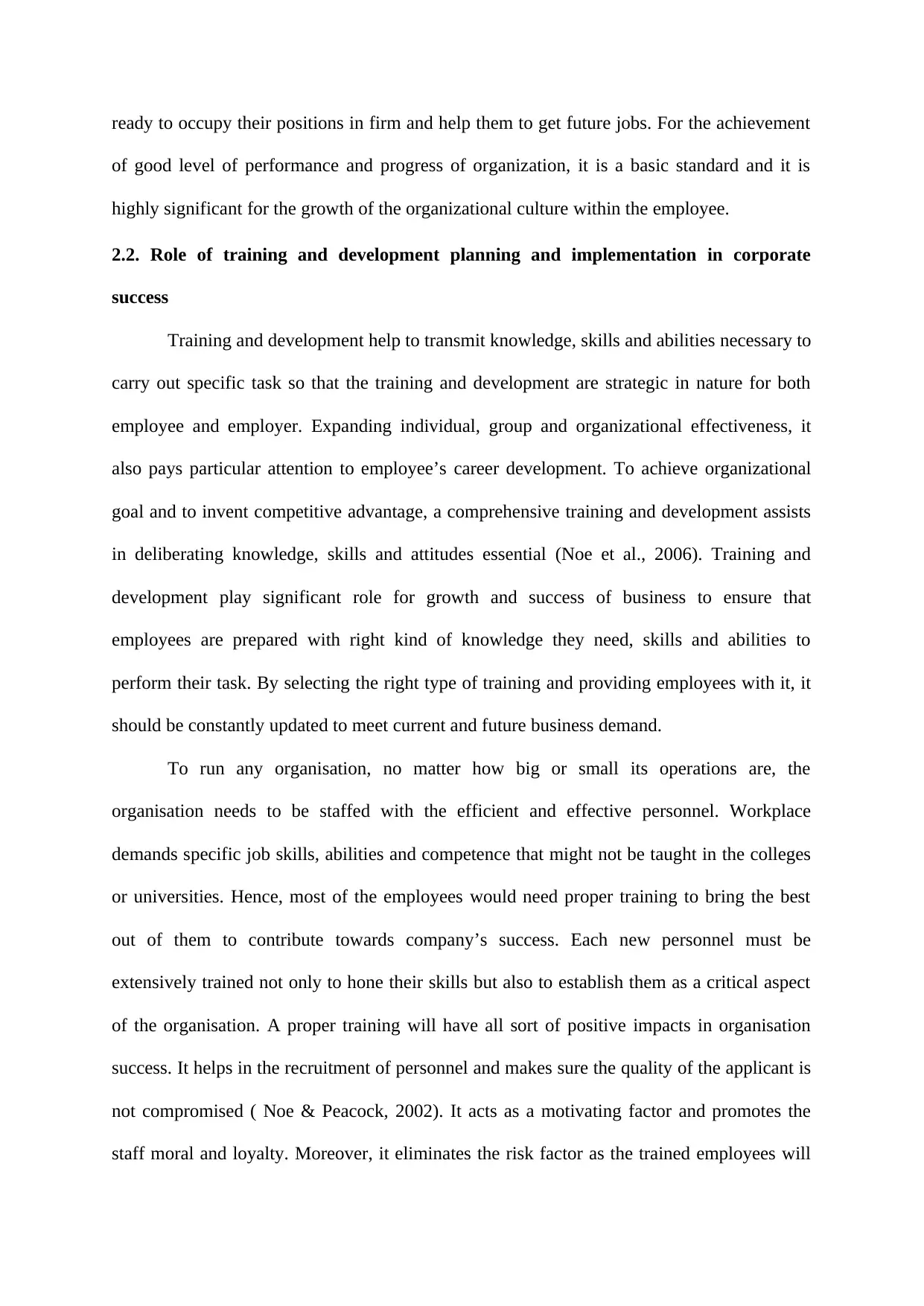
ready to occupy their positions in firm and help them to get future jobs. For the achievement
of good level of performance and progress of organization, it is a basic standard and it is
highly significant for the growth of the organizational culture within the employee.
2.2. Role of training and development planning and implementation in corporate
success
Training and development help to transmit knowledge, skills and abilities necessary to
carry out specific task so that the training and development are strategic in nature for both
employee and employer. Expanding individual, group and organizational effectiveness, it
also pays particular attention to employee’s career development. To achieve organizational
goal and to invent competitive advantage, a comprehensive training and development assists
in deliberating knowledge, skills and attitudes essential (Noe et al., 2006). Training and
development play significant role for growth and success of business to ensure that
employees are prepared with right kind of knowledge they need, skills and abilities to
perform their task. By selecting the right type of training and providing employees with it, it
should be constantly updated to meet current and future business demand.
To run any organisation, no matter how big or small its operations are, the
organisation needs to be staffed with the efficient and effective personnel. Workplace
demands specific job skills, abilities and competence that might not be taught in the colleges
or universities. Hence, most of the employees would need proper training to bring the best
out of them to contribute towards company’s success. Each new personnel must be
extensively trained not only to hone their skills but also to establish them as a critical aspect
of the organisation. A proper training will have all sort of positive impacts in organisation
success. It helps in the recruitment of personnel and makes sure the quality of the applicant is
not compromised ( Noe & Peacock, 2002). It acts as a motivating factor and promotes the
staff moral and loyalty. Moreover, it eliminates the risk factor as the trained employees will
of good level of performance and progress of organization, it is a basic standard and it is
highly significant for the growth of the organizational culture within the employee.
2.2. Role of training and development planning and implementation in corporate
success
Training and development help to transmit knowledge, skills and abilities necessary to
carry out specific task so that the training and development are strategic in nature for both
employee and employer. Expanding individual, group and organizational effectiveness, it
also pays particular attention to employee’s career development. To achieve organizational
goal and to invent competitive advantage, a comprehensive training and development assists
in deliberating knowledge, skills and attitudes essential (Noe et al., 2006). Training and
development play significant role for growth and success of business to ensure that
employees are prepared with right kind of knowledge they need, skills and abilities to
perform their task. By selecting the right type of training and providing employees with it, it
should be constantly updated to meet current and future business demand.
To run any organisation, no matter how big or small its operations are, the
organisation needs to be staffed with the efficient and effective personnel. Workplace
demands specific job skills, abilities and competence that might not be taught in the colleges
or universities. Hence, most of the employees would need proper training to bring the best
out of them to contribute towards company’s success. Each new personnel must be
extensively trained not only to hone their skills but also to establish them as a critical aspect
of the organisation. A proper training will have all sort of positive impacts in organisation
success. It helps in the recruitment of personnel and makes sure the quality of the applicant is
not compromised ( Noe & Peacock, 2002). It acts as a motivating factor and promotes the
staff moral and loyalty. Moreover, it eliminates the risk factor as the trained employees will
⊘ This is a preview!⊘
Do you want full access?
Subscribe today to unlock all pages.

Trusted by 1+ million students worldwide
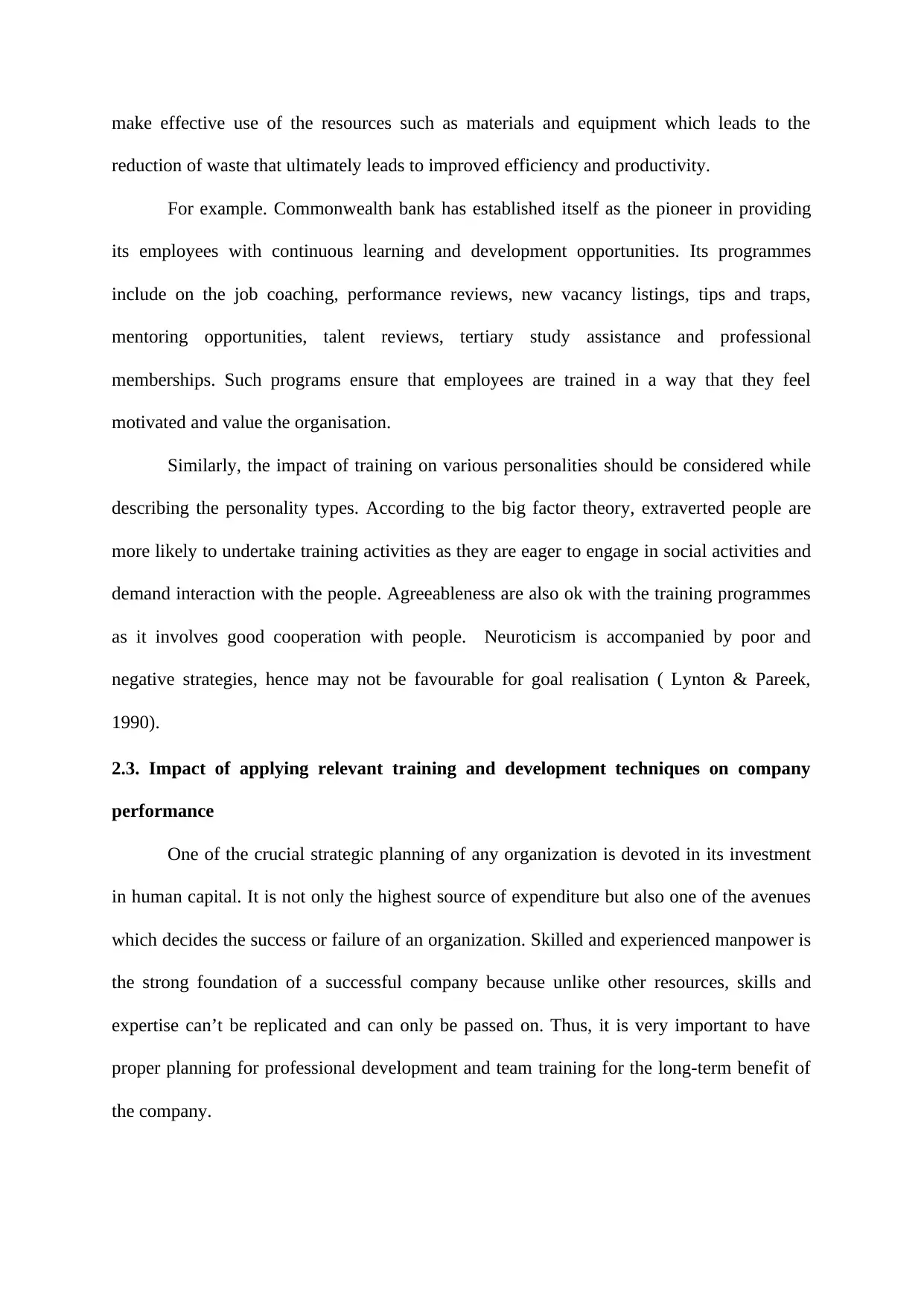
make effective use of the resources such as materials and equipment which leads to the
reduction of waste that ultimately leads to improved efficiency and productivity.
For example. Commonwealth bank has established itself as the pioneer in providing
its employees with continuous learning and development opportunities. Its programmes
include on the job coaching, performance reviews, new vacancy listings, tips and traps,
mentoring opportunities, talent reviews, tertiary study assistance and professional
memberships. Such programs ensure that employees are trained in a way that they feel
motivated and value the organisation.
Similarly, the impact of training on various personalities should be considered while
describing the personality types. According to the big factor theory, extraverted people are
more likely to undertake training activities as they are eager to engage in social activities and
demand interaction with the people. Agreeableness are also ok with the training programmes
as it involves good cooperation with people. Neuroticism is accompanied by poor and
negative strategies, hence may not be favourable for goal realisation ( Lynton & Pareek,
1990).
2.3. Impact of applying relevant training and development techniques on company
performance
One of the crucial strategic planning of any organization is devoted in its investment
in human capital. It is not only the highest source of expenditure but also one of the avenues
which decides the success or failure of an organization. Skilled and experienced manpower is
the strong foundation of a successful company because unlike other resources, skills and
expertise can’t be replicated and can only be passed on. Thus, it is very important to have
proper planning for professional development and team training for the long-term benefit of
the company.
reduction of waste that ultimately leads to improved efficiency and productivity.
For example. Commonwealth bank has established itself as the pioneer in providing
its employees with continuous learning and development opportunities. Its programmes
include on the job coaching, performance reviews, new vacancy listings, tips and traps,
mentoring opportunities, talent reviews, tertiary study assistance and professional
memberships. Such programs ensure that employees are trained in a way that they feel
motivated and value the organisation.
Similarly, the impact of training on various personalities should be considered while
describing the personality types. According to the big factor theory, extraverted people are
more likely to undertake training activities as they are eager to engage in social activities and
demand interaction with the people. Agreeableness are also ok with the training programmes
as it involves good cooperation with people. Neuroticism is accompanied by poor and
negative strategies, hence may not be favourable for goal realisation ( Lynton & Pareek,
1990).
2.3. Impact of applying relevant training and development techniques on company
performance
One of the crucial strategic planning of any organization is devoted in its investment
in human capital. It is not only the highest source of expenditure but also one of the avenues
which decides the success or failure of an organization. Skilled and experienced manpower is
the strong foundation of a successful company because unlike other resources, skills and
expertise can’t be replicated and can only be passed on. Thus, it is very important to have
proper planning for professional development and team training for the long-term benefit of
the company.
Paraphrase This Document
Need a fresh take? Get an instant paraphrase of this document with our AI Paraphraser

Having relevant training and development plans in place will have positive impact on
company performance. It will allow the employees to have better understanding of
company’s operations or their tasks at hand. This will in turn help to achieve better results,
minimizes error rate and improves productivity which will have positive impact on
company’s output. For example, in Coles the service check-out employee is properly trained
to handle cash counter. After a rigorous training of a month, the employee is then allowed to
handle the counter. The training provides the platform for an employee to learn from
mistakes, handle various situations in a mock environment, and to have constructive feedback
to work on.
Similarly, having a plan for professional development will give employees a long-
term vision of their career which can in turn improve their motivation. For instance, if the
employees know their development goals and how they can progress in the corporate ladder
they will have motivation to do better and achieve their aim for growth whereas if there are
no plans for professional development, some employees might feel stagnant which might lead
to higher employee turnover.
Likewise, teamwork and team building activities can be enhanced when the company
has relevant training and development techniques. Teamwork is important to every company
because organizational goals can’t be achieved individually. It can be achieved when all the
employees work together collaboratively. Providing relevant team training will have positive
impact on employee’s behavior as they will feel valued for an organization as a group. This
will enhance teamwork as they will work in unison by contributing to group with ideas,
suggestions and efforts. There will be healthy respect for diversity of thoughts which is
important for company’s success. For instance, in big organizations every task is done by a
group channel and not by an individual in particular. So, having group training will enhance
company performance. It will allow the employees to have better understanding of
company’s operations or their tasks at hand. This will in turn help to achieve better results,
minimizes error rate and improves productivity which will have positive impact on
company’s output. For example, in Coles the service check-out employee is properly trained
to handle cash counter. After a rigorous training of a month, the employee is then allowed to
handle the counter. The training provides the platform for an employee to learn from
mistakes, handle various situations in a mock environment, and to have constructive feedback
to work on.
Similarly, having a plan for professional development will give employees a long-
term vision of their career which can in turn improve their motivation. For instance, if the
employees know their development goals and how they can progress in the corporate ladder
they will have motivation to do better and achieve their aim for growth whereas if there are
no plans for professional development, some employees might feel stagnant which might lead
to higher employee turnover.
Likewise, teamwork and team building activities can be enhanced when the company
has relevant training and development techniques. Teamwork is important to every company
because organizational goals can’t be achieved individually. It can be achieved when all the
employees work together collaboratively. Providing relevant team training will have positive
impact on employee’s behavior as they will feel valued for an organization as a group. This
will enhance teamwork as they will work in unison by contributing to group with ideas,
suggestions and efforts. There will be healthy respect for diversity of thoughts which is
important for company’s success. For instance, in big organizations every task is done by a
group channel and not by an individual in particular. So, having group training will enhance
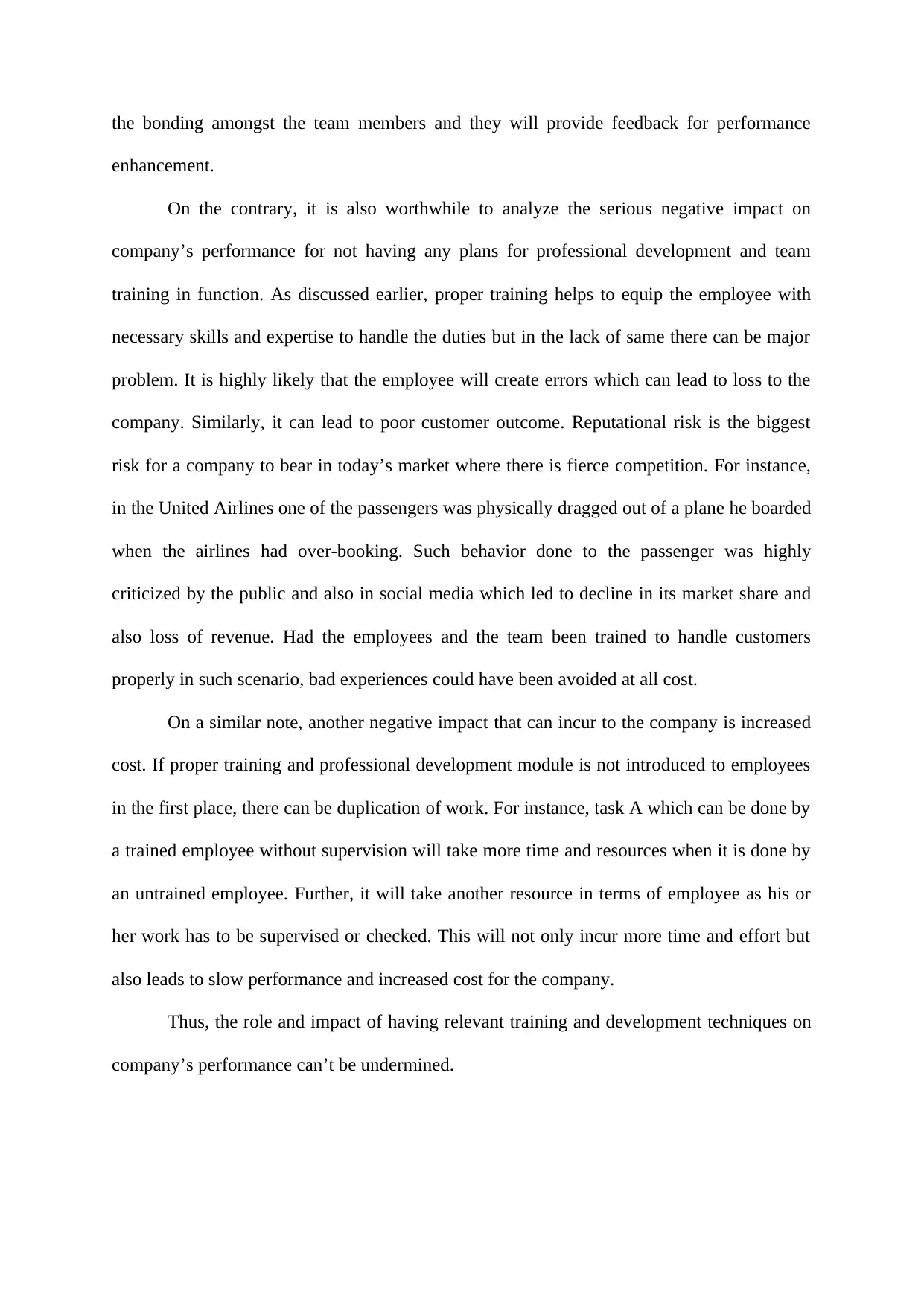
the bonding amongst the team members and they will provide feedback for performance
enhancement.
On the contrary, it is also worthwhile to analyze the serious negative impact on
company’s performance for not having any plans for professional development and team
training in function. As discussed earlier, proper training helps to equip the employee with
necessary skills and expertise to handle the duties but in the lack of same there can be major
problem. It is highly likely that the employee will create errors which can lead to loss to the
company. Similarly, it can lead to poor customer outcome. Reputational risk is the biggest
risk for a company to bear in today’s market where there is fierce competition. For instance,
in the United Airlines one of the passengers was physically dragged out of a plane he boarded
when the airlines had over-booking. Such behavior done to the passenger was highly
criticized by the public and also in social media which led to decline in its market share and
also loss of revenue. Had the employees and the team been trained to handle customers
properly in such scenario, bad experiences could have been avoided at all cost.
On a similar note, another negative impact that can incur to the company is increased
cost. If proper training and professional development module is not introduced to employees
in the first place, there can be duplication of work. For instance, task A which can be done by
a trained employee without supervision will take more time and resources when it is done by
an untrained employee. Further, it will take another resource in terms of employee as his or
her work has to be supervised or checked. This will not only incur more time and effort but
also leads to slow performance and increased cost for the company.
Thus, the role and impact of having relevant training and development techniques on
company’s performance can’t be undermined.
enhancement.
On the contrary, it is also worthwhile to analyze the serious negative impact on
company’s performance for not having any plans for professional development and team
training in function. As discussed earlier, proper training helps to equip the employee with
necessary skills and expertise to handle the duties but in the lack of same there can be major
problem. It is highly likely that the employee will create errors which can lead to loss to the
company. Similarly, it can lead to poor customer outcome. Reputational risk is the biggest
risk for a company to bear in today’s market where there is fierce competition. For instance,
in the United Airlines one of the passengers was physically dragged out of a plane he boarded
when the airlines had over-booking. Such behavior done to the passenger was highly
criticized by the public and also in social media which led to decline in its market share and
also loss of revenue. Had the employees and the team been trained to handle customers
properly in such scenario, bad experiences could have been avoided at all cost.
On a similar note, another negative impact that can incur to the company is increased
cost. If proper training and professional development module is not introduced to employees
in the first place, there can be duplication of work. For instance, task A which can be done by
a trained employee without supervision will take more time and resources when it is done by
an untrained employee. Further, it will take another resource in terms of employee as his or
her work has to be supervised or checked. This will not only incur more time and effort but
also leads to slow performance and increased cost for the company.
Thus, the role and impact of having relevant training and development techniques on
company’s performance can’t be undermined.
⊘ This is a preview!⊘
Do you want full access?
Subscribe today to unlock all pages.

Trusted by 1+ million students worldwide

2.4. Relationship between training and development and organisational culture
It has been said that training and development can play an important role, either
positive or negative, on organisational culture. According to Hoof et al. (2008) a positive
organisational culture can be established if the managers provide group activities and
assignments to the employees. Workshops and seminars involving significant amount of
group activities could lead employees to understand that the impact of the collaborative work
can create a positive working environment. For instance, groups formed with members from
different departments would increase the communication skills among employees while they
can test their boundaries and adjust their interpersonal communication skills accordingly.
According to a study conducted by Giaccone in 2007 it’s been observed that regular
training and development activities help establishing the positive organisational culture. The
study found out that regular training has brought more than 30% of amelioration in various
aspects of employee productivity. The employees from organisations with strong values and
culture are more likely to bring their individual skills in full and to create a group synergy
resulting with a coherence Falcone (1991)
Cabrita and Perista’s (2006) pinpointed the correlation between job satisfaction and
customer satisfaction. According to their study, workers participation and the communication
between superior and subordinates have remarkable influence on workers’ job satisfaction in
large corporations. Employees with more freedom of expressing themselves deliver a higher
level of positive customer experience. Employees become more persuasive and convincing.
Trainings targeting workers participation and their expression play a positive impact
on organisational culture. Therefore, employees appreciate the components of the company
culture and interact well with each other as well as their customers.
Conversely, Frey and Stutzer (2002) defined that poorly designed training programs
can lead to negative effects on organisational culture. Employees arguing with each other,
It has been said that training and development can play an important role, either
positive or negative, on organisational culture. According to Hoof et al. (2008) a positive
organisational culture can be established if the managers provide group activities and
assignments to the employees. Workshops and seminars involving significant amount of
group activities could lead employees to understand that the impact of the collaborative work
can create a positive working environment. For instance, groups formed with members from
different departments would increase the communication skills among employees while they
can test their boundaries and adjust their interpersonal communication skills accordingly.
According to a study conducted by Giaccone in 2007 it’s been observed that regular
training and development activities help establishing the positive organisational culture. The
study found out that regular training has brought more than 30% of amelioration in various
aspects of employee productivity. The employees from organisations with strong values and
culture are more likely to bring their individual skills in full and to create a group synergy
resulting with a coherence Falcone (1991)
Cabrita and Perista’s (2006) pinpointed the correlation between job satisfaction and
customer satisfaction. According to their study, workers participation and the communication
between superior and subordinates have remarkable influence on workers’ job satisfaction in
large corporations. Employees with more freedom of expressing themselves deliver a higher
level of positive customer experience. Employees become more persuasive and convincing.
Trainings targeting workers participation and their expression play a positive impact
on organisational culture. Therefore, employees appreciate the components of the company
culture and interact well with each other as well as their customers.
Conversely, Frey and Stutzer (2002) defined that poorly designed training programs
can lead to negative effects on organisational culture. Employees arguing with each other,
Paraphrase This Document
Need a fresh take? Get an instant paraphrase of this document with our AI Paraphraser
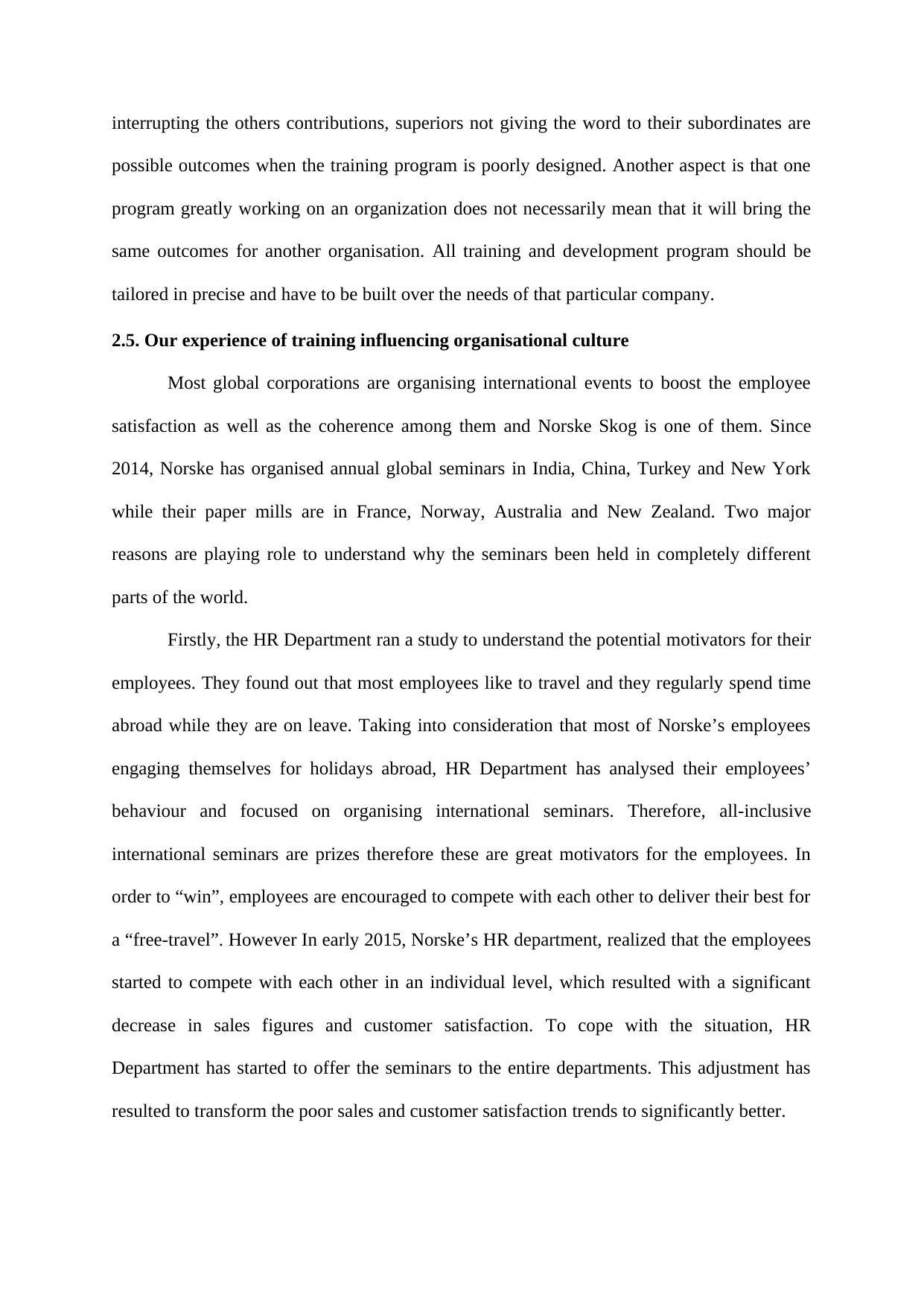
interrupting the others contributions, superiors not giving the word to their subordinates are
possible outcomes when the training program is poorly designed. Another aspect is that one
program greatly working on an organization does not necessarily mean that it will bring the
same outcomes for another organisation. All training and development program should be
tailored in precise and have to be built over the needs of that particular company.
2.5. Our experience of training influencing organisational culture
Most global corporations are organising international events to boost the employee
satisfaction as well as the coherence among them and Norske Skog is one of them. Since
2014, Norske has organised annual global seminars in India, China, Turkey and New York
while their paper mills are in France, Norway, Australia and New Zealand. Two major
reasons are playing role to understand why the seminars been held in completely different
parts of the world.
Firstly, the HR Department ran a study to understand the potential motivators for their
employees. They found out that most employees like to travel and they regularly spend time
abroad while they are on leave. Taking into consideration that most of Norske’s employees
engaging themselves for holidays abroad, HR Department has analysed their employees’
behaviour and focused on organising international seminars. Therefore, all-inclusive
international seminars are prizes therefore these are great motivators for the employees. In
order to “win”, employees are encouraged to compete with each other to deliver their best for
a “free-travel”. However In early 2015, Norske’s HR department, realized that the employees
started to compete with each other in an individual level, which resulted with a significant
decrease in sales figures and customer satisfaction. To cope with the situation, HR
Department has started to offer the seminars to the entire departments. This adjustment has
resulted to transform the poor sales and customer satisfaction trends to significantly better.
possible outcomes when the training program is poorly designed. Another aspect is that one
program greatly working on an organization does not necessarily mean that it will bring the
same outcomes for another organisation. All training and development program should be
tailored in precise and have to be built over the needs of that particular company.
2.5. Our experience of training influencing organisational culture
Most global corporations are organising international events to boost the employee
satisfaction as well as the coherence among them and Norske Skog is one of them. Since
2014, Norske has organised annual global seminars in India, China, Turkey and New York
while their paper mills are in France, Norway, Australia and New Zealand. Two major
reasons are playing role to understand why the seminars been held in completely different
parts of the world.
Firstly, the HR Department ran a study to understand the potential motivators for their
employees. They found out that most employees like to travel and they regularly spend time
abroad while they are on leave. Taking into consideration that most of Norske’s employees
engaging themselves for holidays abroad, HR Department has analysed their employees’
behaviour and focused on organising international seminars. Therefore, all-inclusive
international seminars are prizes therefore these are great motivators for the employees. In
order to “win”, employees are encouraged to compete with each other to deliver their best for
a “free-travel”. However In early 2015, Norske’s HR department, realized that the employees
started to compete with each other in an individual level, which resulted with a significant
decrease in sales figures and customer satisfaction. To cope with the situation, HR
Department has started to offer the seminars to the entire departments. This adjustment has
resulted to transform the poor sales and customer satisfaction trends to significantly better.

Secondly, managerial departments (sales, accounting, legal etc.) have given the
chance of discovering the countries which they are currently dealing with. For instance, in
2016 accounting team of Australia had the chance to go to India and they have met with the
customers, they had the chance to discuss their problems and to exchange their ideas. And
they realised that most of their difficulties were cultural and the only solution was to identify
the cultural differences and to establish a better communication. However, the limited timing
of seminar would not allow to establish the desired level of communication. Finally, HR
Department has developed further online work-shops and role plays on a monthly basis
during the 3 consecutive months after the seminar. After all, the behaviours within Norske’s
Australia and India accounting teams have significantly changed with, basically,
understanding and respecting each other’s personal values and beliefs.
3. Conclusion
Hence, from the above analysis it is to conclude that training and development are
very necessary for any organisation to improve its employee performance and productivity. It
sharpens the skills of the employees and let them gain more knowledge for the betterment of
not only the company but also of the individual himself. It provide skills and knowledge to
new or current employees that are necessary for performing their jobs and through the
development they are ready to occupy their positions in firm and help them to get future jobs.
Moreover, training and development in an organisation transmit the knowledge, skills and
abilities that are required to carry out specific task strategically for both employee and
employer. A proper training has all sort of positive impacts in the organisation success. It
helps in the recruitment of personnel and ensure that the quality of the applicant is not
compromised in any way.
Furthermore, it is also to mention that workers participation and the communication in
between the superior and subordinates influence the level of job satisfaction of the employees
chance of discovering the countries which they are currently dealing with. For instance, in
2016 accounting team of Australia had the chance to go to India and they have met with the
customers, they had the chance to discuss their problems and to exchange their ideas. And
they realised that most of their difficulties were cultural and the only solution was to identify
the cultural differences and to establish a better communication. However, the limited timing
of seminar would not allow to establish the desired level of communication. Finally, HR
Department has developed further online work-shops and role plays on a monthly basis
during the 3 consecutive months after the seminar. After all, the behaviours within Norske’s
Australia and India accounting teams have significantly changed with, basically,
understanding and respecting each other’s personal values and beliefs.
3. Conclusion
Hence, from the above analysis it is to conclude that training and development are
very necessary for any organisation to improve its employee performance and productivity. It
sharpens the skills of the employees and let them gain more knowledge for the betterment of
not only the company but also of the individual himself. It provide skills and knowledge to
new or current employees that are necessary for performing their jobs and through the
development they are ready to occupy their positions in firm and help them to get future jobs.
Moreover, training and development in an organisation transmit the knowledge, skills and
abilities that are required to carry out specific task strategically for both employee and
employer. A proper training has all sort of positive impacts in the organisation success. It
helps in the recruitment of personnel and ensure that the quality of the applicant is not
compromised in any way.
Furthermore, it is also to mention that workers participation and the communication in
between the superior and subordinates influence the level of job satisfaction of the employees
⊘ This is a preview!⊘
Do you want full access?
Subscribe today to unlock all pages.

Trusted by 1+ million students worldwide
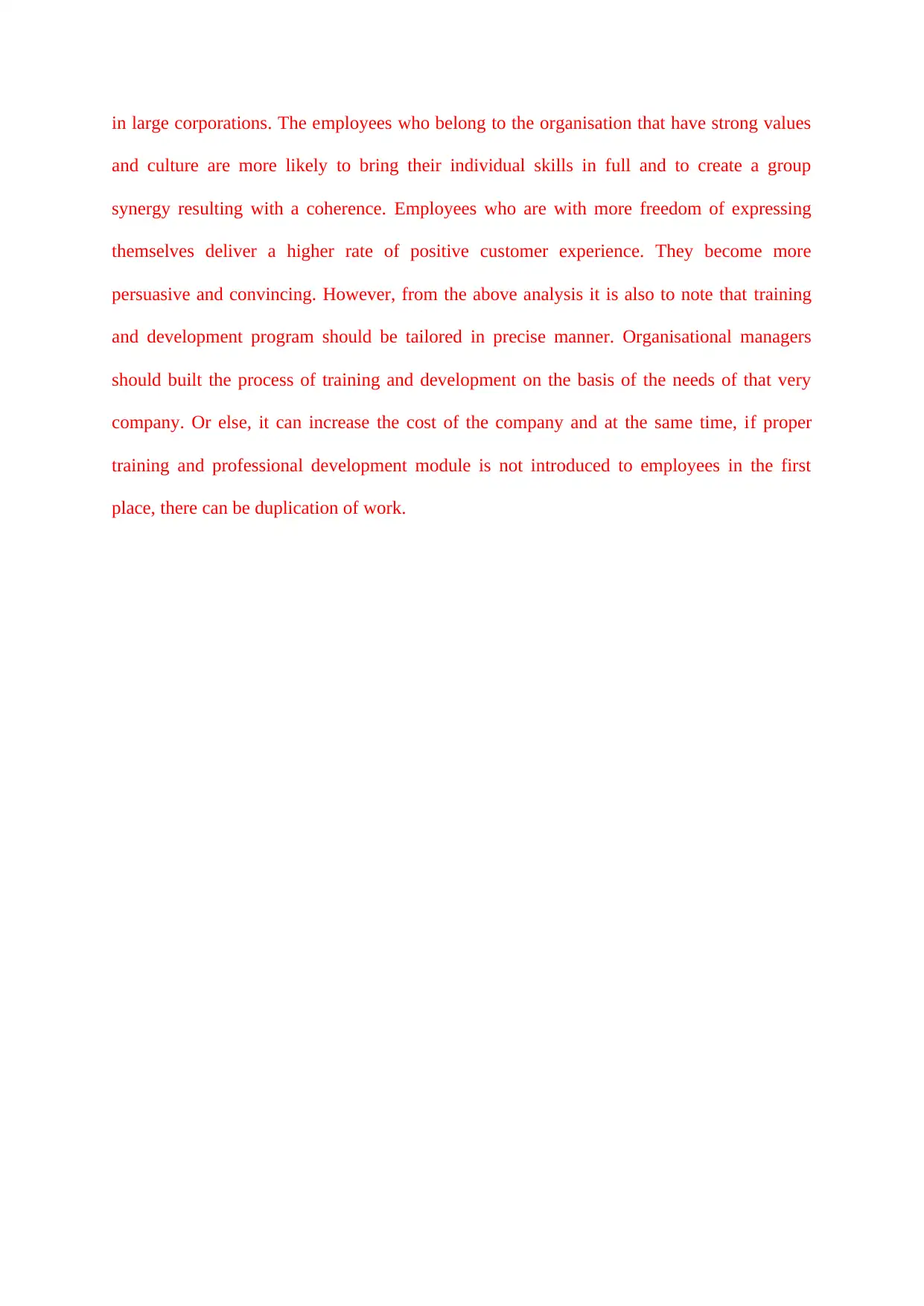
in large corporations. The employees who belong to the organisation that have strong values
and culture are more likely to bring their individual skills in full and to create a group
synergy resulting with a coherence. Employees who are with more freedom of expressing
themselves deliver a higher rate of positive customer experience. They become more
persuasive and convincing. However, from the above analysis it is also to note that training
and development program should be tailored in precise manner. Organisational managers
should built the process of training and development on the basis of the needs of that very
company. Or else, it can increase the cost of the company and at the same time, if proper
training and professional development module is not introduced to employees in the first
place, there can be duplication of work.
and culture are more likely to bring their individual skills in full and to create a group
synergy resulting with a coherence. Employees who are with more freedom of expressing
themselves deliver a higher rate of positive customer experience. They become more
persuasive and convincing. However, from the above analysis it is also to note that training
and development program should be tailored in precise manner. Organisational managers
should built the process of training and development on the basis of the needs of that very
company. Or else, it can increase the cost of the company and at the same time, if proper
training and professional development module is not introduced to employees in the first
place, there can be duplication of work.
Paraphrase This Document
Need a fresh take? Get an instant paraphrase of this document with our AI Paraphraser

References
Aguinis, H. and Kraiger, K., 2009. Benefits of training and development for individuals and
teams, organizations, and society. Annual review of psychology, 60, pp.451-474.
Buelens M., Van Der Boeck, H. & Vanderheyden, K.,2007, Organisational Behavior, 3rd
ed.,McGraw Hill, Australia
Aguinis, H. and Kraiger, K., 2009. Benefits of training and development for individuals and
teams, organizations, and society. Annual review of psychology, 60, pp.451-474.
Buelens M., Van Der Boeck, H. & Vanderheyden, K.,2007, Organisational Behavior, 3rd
ed.,McGraw Hill, Australia
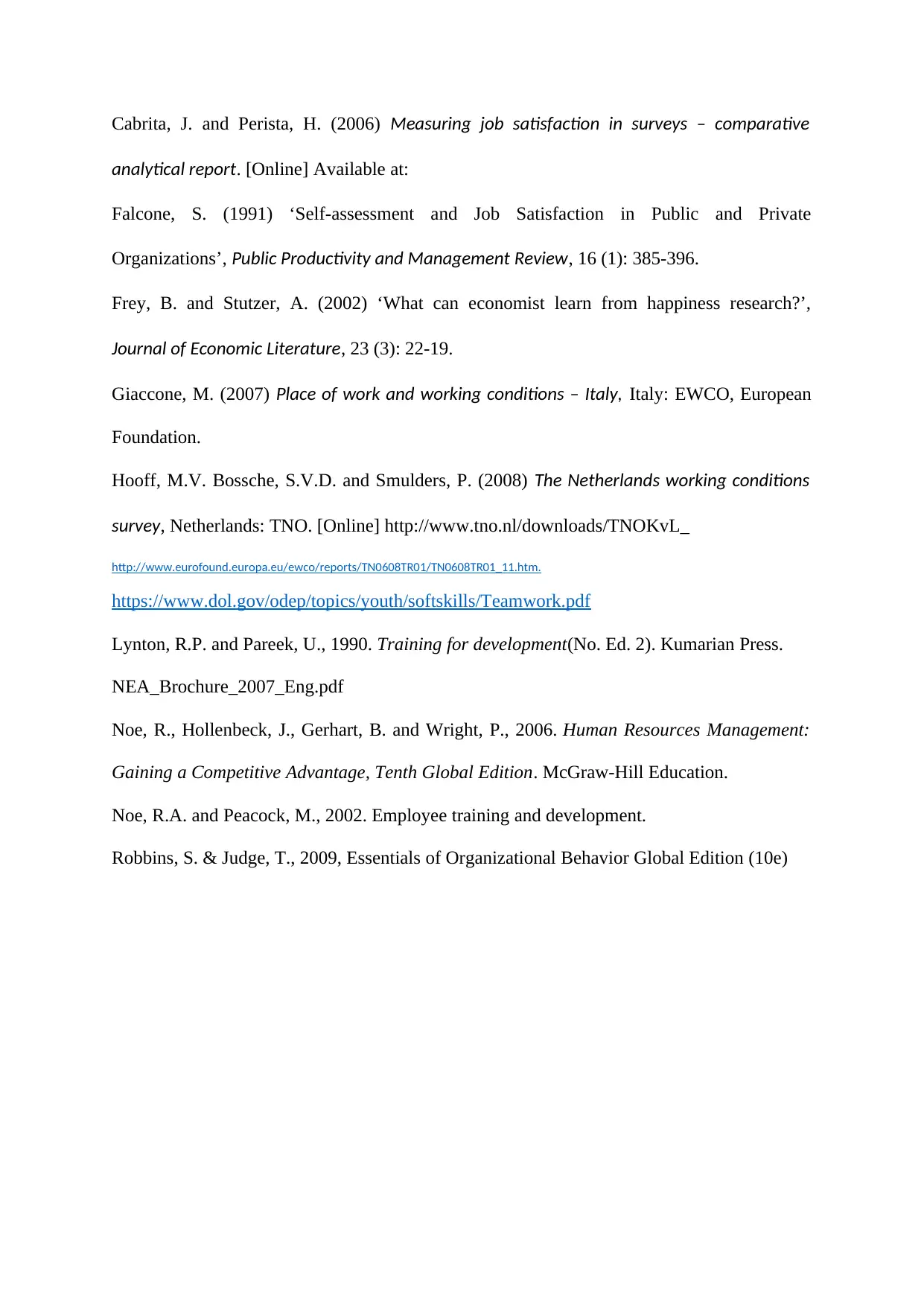
Cabrita, J. and Perista, H. (2006) Measuring job satisfaction in surveys – comparative
analytical report. [Online] Available at:
Falcone, S. (1991) ‘Self-assessment and Job Satisfaction in Public and Private
Organizations’, Public Productivity and Management Review, 16 (1): 385-396.
Frey, B. and Stutzer, A. (2002) ‘What can economist learn from happiness research?’,
Journal of Economic Literature, 23 (3): 22-19.
Giaccone, M. (2007) Place of work and working conditions – Italy, Italy: EWCO, European
Foundation.
Hooff, M.V. Bossche, S.V.D. and Smulders, P. (2008) The Netherlands working conditions
survey, Netherlands: TNO. [Online] http://www.tno.nl/downloads/TNOKvL_
http://www.eurofound.europa.eu/ewco/reports/TN0608TR01/TN0608TR01_11.htm.
https://www.dol.gov/odep/topics/youth/softskills/Teamwork.pdf
Lynton, R.P. and Pareek, U., 1990. Training for development(No. Ed. 2). Kumarian Press.
NEA_Brochure_2007_Eng.pdf
Noe, R., Hollenbeck, J., Gerhart, B. and Wright, P., 2006. Human Resources Management:
Gaining a Competitive Advantage, Tenth Global Edition. McGraw-Hill Education.
Noe, R.A. and Peacock, M., 2002. Employee training and development.
Robbins, S. & Judge, T., 2009, Essentials of Organizational Behavior Global Edition (10e)
analytical report. [Online] Available at:
Falcone, S. (1991) ‘Self-assessment and Job Satisfaction in Public and Private
Organizations’, Public Productivity and Management Review, 16 (1): 385-396.
Frey, B. and Stutzer, A. (2002) ‘What can economist learn from happiness research?’,
Journal of Economic Literature, 23 (3): 22-19.
Giaccone, M. (2007) Place of work and working conditions – Italy, Italy: EWCO, European
Foundation.
Hooff, M.V. Bossche, S.V.D. and Smulders, P. (2008) The Netherlands working conditions
survey, Netherlands: TNO. [Online] http://www.tno.nl/downloads/TNOKvL_
http://www.eurofound.europa.eu/ewco/reports/TN0608TR01/TN0608TR01_11.htm.
https://www.dol.gov/odep/topics/youth/softskills/Teamwork.pdf
Lynton, R.P. and Pareek, U., 1990. Training for development(No. Ed. 2). Kumarian Press.
NEA_Brochure_2007_Eng.pdf
Noe, R., Hollenbeck, J., Gerhart, B. and Wright, P., 2006. Human Resources Management:
Gaining a Competitive Advantage, Tenth Global Edition. McGraw-Hill Education.
Noe, R.A. and Peacock, M., 2002. Employee training and development.
Robbins, S. & Judge, T., 2009, Essentials of Organizational Behavior Global Edition (10e)
⊘ This is a preview!⊘
Do you want full access?
Subscribe today to unlock all pages.

Trusted by 1+ million students worldwide
1 out of 12
Related Documents
Your All-in-One AI-Powered Toolkit for Academic Success.
+13062052269
info@desklib.com
Available 24*7 on WhatsApp / Email
![[object Object]](/_next/static/media/star-bottom.7253800d.svg)
Unlock your academic potential
Copyright © 2020–2025 A2Z Services. All Rights Reserved. Developed and managed by ZUCOL.





